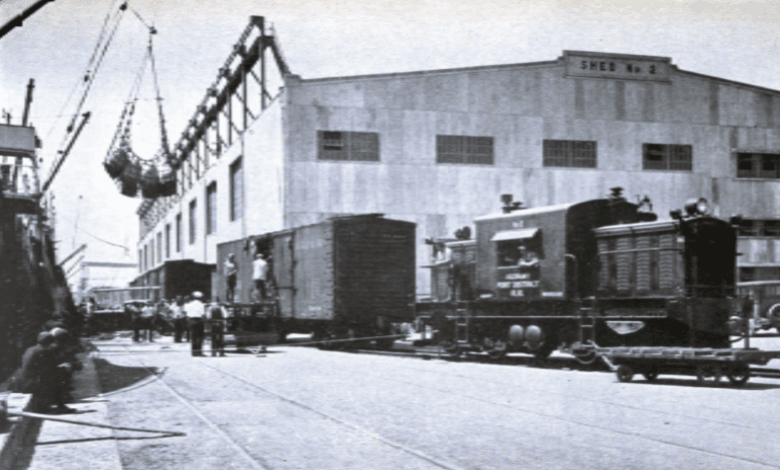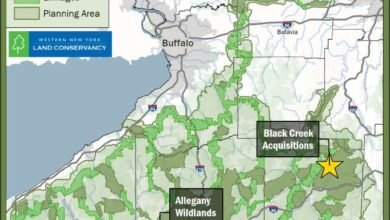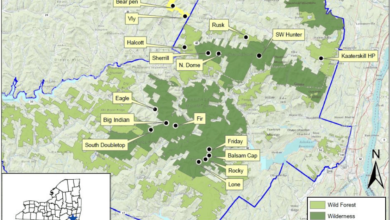Port of Albany: Piers, Wharves and Docks in 1941


 The following description is from 1941.
The following description is from 1941.
There are 30 terminal facilities at the Port of Albany, including those on the east side of the Hudson River at and below Rensselaer. These facilities provide a total of 18,661 linear feet of berthing space with depths ranging from 33 to 6 feet at mean low water.
Of this number 10 with a total berthage of 2,948 feet are used for handling petroleum products and five with a berthage of 2,525 feet are used for handling miscellaneous cargo in foreign and domestic trade. Two facilities with 1,370 feet of berthage are used for handling grain, one with 200 feet provides space for the movement of iron and steel scrap, while another with 1,617 feet of berthing space is used exclusively for handling lumber.
A large wharf with 1,550 feet of berthing space is used for handling cargoes moving by barge canal and one with 900 feet is classified as a recreational pier serving as a landing for small craft.
One wharf is used by a Federal agency, one by a railroad company, one by a chemical plant, one by a shipyard and one is a steamboat passenger landing. These five wharves have a total berthing space of 2,777 linear feet. Four wharves not being used provide a total of 4,774 linear feet of berthing space, three of which are owned by railroad companies.
The publicly owned wharves include the water frontage operated by the Albany Port District Commission which is shown in this report as five separate terminals or berths for the handling of miscellaneous cargo in foreign and domestic trade, two for grain handling and one for lumber.
The principal shipping activity of Albany is at the wharves of the Albany Port District Commission in the southern part of the city generally referred to as The Port.
It consists of a concrete bulk head 4,195 feet long having a depth of 30 feet of water at lowest low water and adequately served with railroad trackage and transit sheds as well as a grain elevator of 13,500,000 bushels capacity. Thus bulkhead may be expanded on the south by an additional 1,500 feet when the needs require.
The trackage of the Port Terminal Railroad owned and operated by the Port District Commission extends along the edge of the bulkhead permitting direct interchange between vessel and car and also extends in the rear of the transit sheds and warehouse where the loading platforms are on a level with the car floor. The concrete floors of the transit sheds and warehouse are slightly inclined to produce this elevation in the rear.
The Port Terminal Railroad serves the port district on the west side of this river and connects with the Delaware & Hudson and New York Central railroads.
The five transit sheds on the Albany Port District facilities are of steel frame construction with metal sides and concrete floors and are equipped with cargo beams along the face of each building. Numerous electric outlets are provided in the sheds for the operation of handling equipment.
The grain elevator is operated by the Cargill Grain Co. Inc. under lease from the Port District Commission. A battery of eight marine legs of the pneumatic type is provided for the transfer of grain from vessel to elevator which can be accomplished at the rate of 20,000 bushels an hour. Two units of loading spouts connected with the elevator by belt conveyors permit the loading of vessels at the rate of 100,000 bushels an hour.
Other establishments in the port district at the present time are the Cooperative Grange League Federation [a farmer owned cooperative formed by The Grange, The Dairymen’s League, and Farm Bureau Federation in about 1920; the GLF was one of three cooperatives that created AGWAY in 1964] and the Molasses Products Corporation.
The former concern situated north of the grain elevator operates a feed mill producing various dairy, hog, and poultry feeds.
[Commercial Solvents Corporation was founded by the Allied War Board [Federal War Industries Board] in 1917 and industrialized the fermentation process for microbial production of acetone used in making explosives. Private owners took over after the war, using the company’s Midwest plants to make a variety of fermentation products, including alcohol. The company spun-off Molasses Products Corp. in 1933.]The plant is provided with a pneumatic marine leg for the unloading of vessels and is also equipped to receive grain directly from the Port District elevator as well as molasses from the tanks of the Molasses Products Corporation.
The storage tanks of the Molasses Products Corporation are situated in the vicinity of the feed mill and are connected with the bulkhead by two 12 inch pipes for the handling of molasses from and to vessels.

 The lumber terminal of the Port District Commission is situated in the city of Rensselaer directly across the river from the port district area in Albany and consists of a bulkhead 1,205 feet long part of which is constructed of concrete and part of creosoted pile and augmented with 412 feet of mooring piles.
The lumber terminal of the Port District Commission is situated in the city of Rensselaer directly across the river from the port district area in Albany and consists of a bulkhead 1,205 feet long part of which is constructed of concrete and part of creosoted pile and augmented with 412 feet of mooring piles.
The port area on the east side of the river comprises 106 acres and is served by the New York Central Railroad the trackage extending along the bulkhead as well as throughout the area. The depth of water at the bulkhead is 30 feet at lower low water.
The lumber handling facilities consist of a row of seven steel cargo masts near the stringpiece [a heavy squared timber lying along the top of the piles forming a dock front] for use in unloading vessels and six lumber carriers with a capacity of 3,000 feet board measure each. Two lumber sheds with a combined floor area of 25,200 square feet are available for the storage of finished lumber.
The terminal of the Delaware & Hudson Railroad on the Albany side of the river includes two wharves which are not in use and a pier for handling bulk sulphur and supplying bunker coal to tow boats. A four-ton tractor crane with a 300 foot reach is available on the pier
The bulkhead at the yard of the New York Central Railroad in the northern section of the Albany waterfront is in poor condition and is used only occasionally for handling cargo from or to vessels. There are no handling facilities on this bulkhead.
The New York State Barge Canal terminal also in the upper section of Albany consists of a concrete bulkhead 1,586 feet long equipped with a 25 ton stiff leg derrick having a 50 foot reach and with two two-ton tractor cranes having 30 foot reaches.
It is served by a branch track of the Delaware & Hudson Railroad. While this terminal is designed principally for use in connection with barge canal traffic it may be used by vessels not engaged in canal traffic.
The facilities on the Rensselaer side of the river consist mainly of the terminals of oil companies whose pipe lines extend from the river to storage tanks in the rear. The water front facilities are served by well equipped fire departments of the cities of Albany and Rensselaer. These services are supplemented by additional fire fighting equipment at piers wharves and warehouses
The sheds on the port commission wharves are entirely fireproof and the goods held in them are protected from fire by numerous hydrants and hose reels an automatic sprinkler system portable extinguishers and an ADT fire alarm system.
The Albany Port District Commission operates two traveling gantry cranes which have lift capacities of 30 tons. There is a 25 ton stiff leg derrick at the Barge Canal Terminal and a 50 ton stiff leg derrick at the Cargill Shipyard.
[Cargill built a small shipyard alongside its grain elevators to build an innovative articulated barge; the yard also built a 12,500-ton tanker. At the Navy’s urging, Cargill built a second much larger yard for the World War Two effort at Port Savage, MN, 14 miles from the Mississippi River.]Hoisting equipment afloat consists of two derrick barges owned and operated by Ulster Davis Inc., each of which is equipped with a 10 ton revolving crane. One of these cranes has a maximum reach of 60 feet and the other a maximum reach of 65 feet .When not in actual operation these barges are based either at Albany or at Rensselaer.
The terminal installations operated by the Albany Port District Commission on both sides of the river include extensive areas for open storage as well as for industrial development.
On the Rensselaer side, the lumber terminal comprises 106 areas, practically all of which is available for open storage. About half of this area is illuminated by flood lighting.
The entire area is served by trackage of the Port District Railroad which connects with the New York Central Lines. The wharf at the terminal has 617 feet of berthing space with 30 feet of water alongside.
On the west side of the river at the port of Albany proper, there are approximately 47 acres between the transit sheds and the railroad yards in the rear, as well as approximately 13 acres in the rear of the grain elevator which are intended for industrial development.
These 60 acres are served by trackage of the Port District Railroad connecting with the West Shore Railroad and the Delaware & Hudson Railroad. The wharves at the Port District Terminal have a combined berthing space of 4,195 feet with 30 feet of water alongside.
Read more about the history of the Port of Albany.
This essay was excerpted from Port and Terminal Facilities at the Ports on the Upper Hudson River, 1941 (U.S. Government Printing Office, 1942) and annotated by John Warren.
Illustrations, from above: View along the wharf of the Port District Commission terminal loading cargo from railroad car to steamer, 1941; and the Lumber Terminal in 1941.
Source link




